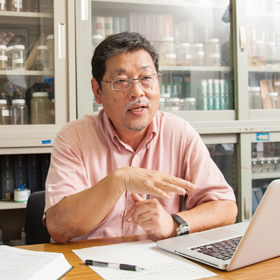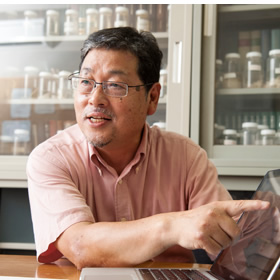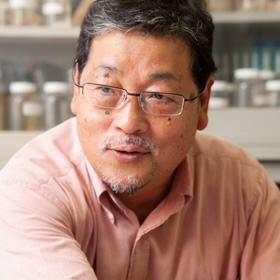 |
|||
 |
|||
| Focus on the unknown potentials of seaweed. Here we have the world’s most advanced research on algal lectins. | |||
|
|||
| However, at the time there were very few examples of utilization of proteins which is one of
the main constituents, and almost no research being conducted on algal lectins in
particular. In the process of extracting protein from seaweed, the substance hardens when
highly viscous polysaccharide components such as Japanese gelatin are present, making
extraction problematic. This was one of the factors holding back research on seaweed
proteins. After that time changes were made to the extraction process, and it is now
possible to refine large amounts of lectin proteins.” Here are some of the figures that
represent a part of the research results. To date around 400 different types of algae have been screened, and it is said that around 240 varieties, or 60% of that amount, contain lectin. Professor Hori has identified a total of 64 lectin isolates (= refined), and characterized the primary structure of 27 lectins, the tertiary structure of 3 lectins (through joint research), and the genetic structure of 50 lectins. According to Professor Hori, “This is the only place in the world with such a large number of algal lectins”. Further, by investigating in detail the glycosylation and bioactivity properties of lectins, he has identified the features of algal lectins – in other words, their application characteristics. |
|||
| What do the characteristics of algal lectins reveal? What are your future research goals? | |||
|
|||
| The second point refers to the fact that most algal lectins are monomers with low
molecular weight. They have an amino acid sequence that differs from known proteins, and
that they form new lectin groups that show strong heat resistance. Point 3 refers to the fact that we have discovered their diverse bioactivity, such as agglutination and lymphocyte mitogenic promotion of various cells, tumor cell proliferation, antivirus, antibacterial, platelet aggregation inhibition, anticoagulant, antiangiogenesis, associativity with food poisoning bacteria, and others. “What these characteristics mean is that we can anticipate that they can be applied for use in biochemistry, clinical and ecosystem reagents, or as constituents in medications or functional foods. We are already moving ahead with some joint research together with professors in medical and science faculties of various universities and also other research institutions, and in the future I would like to proactively work on joint development projects with companies. Our research is focused on applications, studying things that can be useful in some way. This is why we are aiming to have our research results applied widely and used practically in various different fields,” says Professor Hori. |
|||
| How will algal lectins be used in daily life considering future application possibilities? | |||
|
|||
| The third application is development as a biochemical reagent. Investigating an extremely
effective method of simple purification of chicken monoclonal antibodies whose purification
was problematic (patent granted). The fourth application is development as a medicinal constituent. For example, use as an antiviral agent (HIV-1, influenza virus, etc.) or anticancer agent. This is the application currently attracting the most attention, as it would prevent infection and become a carrier for a delivery system to take medication to the cancer cells alone. The fifth application is development as a health food ingredient. Through oral administration, algal lectins have been found to be effective in the prevention of the onset of early-stage colon cancer. The sixth application is development of useful seaweed culturing technology. This is also effective for the development of resources and environmental preservation. The possibilities should continue to expand in the future. We will continue with our research.” |
|||
 Some examples of edible seaweed containing effective lectins |
|||
| Kanji Hori | |||
| Professor, Marine Bioresource Chemistry Hiroshima University Graduate School Completed the doctoral program at Tokyo University Graduate School of
Agriculture, 1976 Retired on March 31, 2015 |
|||



